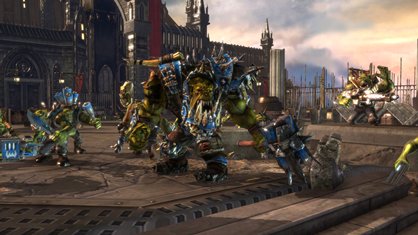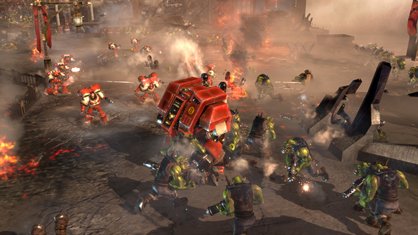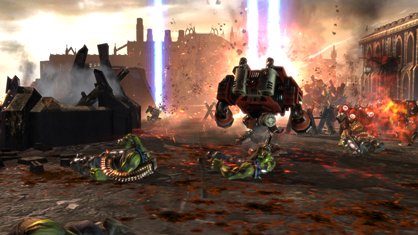Warhammer 40,000: Dawn of War 2
The brutal strategy series breaks new ground, then soaks it in blood
In the year 40,000, the Human Empire is in decline. No longer great conquerers, mankind struggles simply to survive and hold on to its corner of the galaxy - which is easier said than done when a numberless horde of bloodthirsty space-faring Orks constantly pushes in on your borders, killing and pillaging for the sheer thrill of it. (Everyone has a hobby.)

Between humanity and total annihilation are the Space Marines: genetically engineered super-soldiers that stand 8 feet tall and weigh in at 500 pounds, decked out in full scary-ass battle armor. As a Force Commander leading an elite team of Marines aboard a Battle Barge starship, you’re charged with choosing your battles wisely and pushing the invading armies out of Imperial space. It’s essentially the same dark and gritty story we heard when Dawn of War launched in 2004, but the team behind Dawn of War II has no intention of making the same game twice. Instead, it’s planning some radical departures from the first game, which, with the exceptions of innovations like capturable control points and a basic cover system, followed the old-school RTS recipe fairly closely. But seeing the *ahem* competition looming on the horizon, with its time-tested and expertly refined version of that formula (and in a very similar setting, no less) is major motivation to innovate.
In conceiving DoWII, Relic identified three key areas it feels the RTS genre needs to improve in order to compete with shooters and role-playing games.
Point one: RTS games’ lack of long-term goals. “[In a typical RTS] you spend 30-60 minutes building this massive army, collecting all these resources, and building a massive base, and then you just abandon it. You carry nothing with you from one game to the next,” says Lead Designer Jonny Ebbert. “Along with that, you never really feel connected to the terrain - you don’t feel connected to the environment, like you do in Civ IV or something. I’ve never felt that feeling of conquest, I always just feel like I’m fighting over this little patch of dirt, and then I move to another one that seems to have no relation to the last patch of dirt.”

The team’s solution is to strip out nearly all of the treadmill-like base building and resource-collecting tedium and provide you instead with a mobile base of operations - the Battle Barge - and a persistent, dynamic region of space that has been placed under your protection. You’ll cruise freely from planet to planet, deciding which distress calls to respond to and in what order, if at all. Your actions make a difference, and give you a reason to fight for every inch of dirt.
Point two: RTS games suffer from a lack of attachment. “It’s really hard to get attached to what’s going on, because all of your units are nameless and faceless. They have a life expectancy of maybe 30 seconds, right? You just build them and send them into the meat grinder, you never see them again, so why bother?” says Ebbert.
Not here: from the beginning of DoWII’s campaign to the end, you control the same five or six squads of soldiers, each led by a sergeant with a unique name and face, distinct voice acting, and a combat specialty. What happens if they die? All Relic will say for now is that “it will change the way the game is played.” The squad reinforcement system from DoW that allowed you to quickly replace lost squad members anywhere on the battlefield has also been replaced - the exact nature of how that will work hasn’t been disclosed yet, but in the gameplay I saw, new squads entered the battle via drop-pods that dramatically crashed to the ground from the orbiting Battle Barge.

Point three: the reward system that keeps you playing an RPG by offering ever-increasing abilities and weapons just isn’t there in RTS games. “You install the game and start playing it; 60 minutes in, you’re thinking, ‘This is pretty cool,’” says Producer Mark Noseworthy. “Basically, the reward is the content. But after about 60 minutes, you’ve seen the tech tree, seen all your units, seen the abilities - the only reward is winning more games. You have to have a really competitive drive to get anything else out of the genre. We really feel that RTS needs a steady stream of rewards that pushes you toward a long-term goal.” The solution: an RPG-style inventory system. When deciding which missions to accept, you’ll get a glimpse of items - called War Gear - that you’ll earn from a victory, and you can earn bonus War Gear as loot by killing enemies. Some examples include chain swords and hammers with various damage types (flame, frost, acid, electric), heavy bolter machine guns, flame throwers, and multiple types of hardened armor. Equipping your squad sergeants with War Gear upgrades the entire squad, making your soldiers increasingly powerful as the game goes on.
Weekly digests, tales from the communities you love, and more


